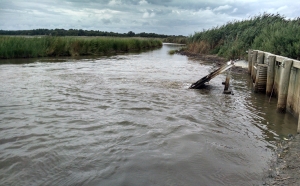The Delaware Division of Fish and Wildlife (DFW) is currently working on coastal impoundment restoration and shoreline/beach restoration through a Hurricane Sandy Relief Grant funded through the National Fish and Wildlife Foundation. All projects are located within the Delaware Bayshore and each project has its own unique approach and purpose with the overall goal being waterfowl and shorebird habitat and community resiliency to future storms. Restoration is currently being planned at three wildlife areas – each project falling in line with the ACJVs priority to support implementation of the Atlantic Flyway Shorebird Initiative, as Delaware’s impoundments provide critical roosting and foraging habitats for migrating shorebirds, especially red knots.

An old water control structure at Little Creek Wildlife Area provides the ability to flood but not adequately manage water within the impoundment. As part of this project, new structures will be installed that are salt tolerant, designed to operate more efficiently, and increase effectiveness of drain and flood capabilities. These new structures will give managers the ability to properly manage water for moist soil vegetation (waterfowl food) and timely/effective drawdowns for shorebirds.
A Restoration Project Highlight: Little Creek Wildlife Area
This project is a new and innovative approach towards habitat restoration while taking into consideration resiliency for future storms. The Little Creek Wildlife Area Main Impoundment is a 450 acre coastal impoundment located due east of Dover and is adjacent to the coastal community of Little Creek. Current conditions of the impoundment include failing dikes, water control structures, inadequate water drainage/circulation, vulnerability to a bay front breach, and subsidence. Prior to Hurricane Sandy, the impoundment was lush with beneficial vegetation for migratory shorebirds and waterfowl as well as other wildlife. After Hurricane Sandy, habitat quality for local and migratory species declined due to the inability to remove salt water from the impoundment. Fortunately the impoundment dikes withstood the storm and did not breach. If the dikes would have breached it is highly likely that, aside from a large investment to restore, the impoundment would have been lost.
To address the serious threat of losing the impoundment to another large storm, the Division of Fish & Wildlife is utilizing hydrodynamic and wave models with different restoration alternatives to determine the best restoration approach. Preliminary results of the project include replacing water control structures, raising dikes, restoring a bayfront breach, restoring historic drainage within an adjacent marsh, and creating a high marsh restoration cell to act as a buffer from the bay. Currently, the immediate need is to restore water control within the impoundment. Once water control is restored through new water control structures, water levels can properly be managed for a variety of species including waterfowl and shorebirds visiting Delaware during their journey along the Atlantic Flyway. This work is expected to be completed during the summer of 2016.


